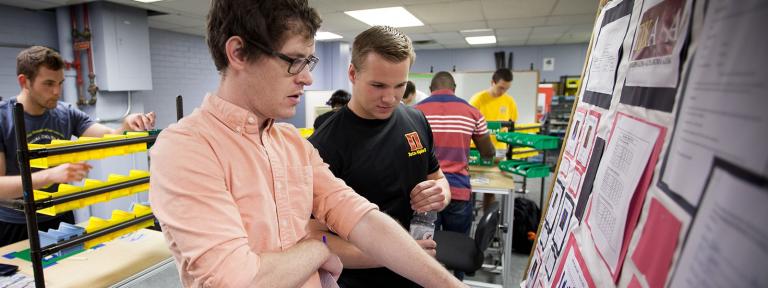
“Being able to apply theories and principles I’ve learned at Kettering in real life situations like this is an invaluable experience.”
On the surface, Industrial Engineering (IE) and healthcare wouldn’t appear to have much in common. But the processes IE is built on are adaptable to any industry, and a group of Kettering University students helped apply those principles in a healthcare setting for their senior capstone project.
The project was in collaboration with St. Mary’s of Michigan in Saginaw. St. Mary’s recently acquired Michigan Cardiovascular Institute. When any entities combine or merge, that often requires a reallocation of resources, changes in staff responsibilities, reorganizing equipment and other procedural changes that industrial engineering fundamentals can help with.
Kettering’s students working on the project -- Jeff Blakely, Adam Kajfez, Steven Campbell, Eve Vitale and Mark Richardson -- looked at the inpatient and outpatient echocardiogram processes and information flow at each facility, studied opportunities for an integrated system, worked with staff to understand the structure of services, billing, patient flow and other functions at the facilities and used IE principles like value stream mapping to study processes to collect and analyze data.
“Being able to apply theories and principles I’ve learned at Kettering in real life situations like this is an invaluable experience,” said Kajfez, who will be working full-time as an industrial engineer at Gulfstream in Savannah, Ga.
The studies and value stream mapping led to recommendations by the capstone students to help the facilities merge services effectively and efficiently. Dr. Matthew Sanders, professor of Industrial Engineering and director of the Center for Culminating Undergraduate Experiences, noted that the team at St. Mary’s was happy with the recommendations and professionalism of the students.
“The capabilities of our students at Kettering make us all look good,” Sanders said. “They are generally very good at narrowing down and understanding a problem to find the root cause. Our students are good with processes and how to make them work efficiently.”
For the senior students, capstone projects like this give them an opportunity to do work in a professional setting right before graduating.
“It’s great having a hands-on experience that I can bring to employers,” said Blakely, who is now a graduate assistant in the IE department.
“Working on the senior capstone project allows you to utilize all the knowledge that you have gained throughout the Kettering experience,” Campbell said.Kettering routinely partners with hospitals and healthcare facilities in the region, both for capstone projects and co-op employment. A new group of Sanders’ students will be doing another project with St. Mary’s, with a goal of streamlining patient transport processes and looking for ways to decrease wait time. Sanders had a group of students complete a capstone project at Genesys Hospital last year.
Dr. Patrick Atkinson's Bioengineering capstone class worked with Hurley Medical Center in December 2011 helping to develop designs for a new children's hospital that would enhance the stay for patients and their families. Kristina Polidan '11, Krista Ply '11 and Christopher Gauthier '11, designed a sensory-based hospital room for children that utilized interactive sound and sight technologies. Melany Gavulic ‘91, president and CEO for Hurley, said the hospital was "thrilled with the product the students came up with and plan to incorporate it into our short and long term plans for the Children’s Hospital.”
All three Flint area hospitals -- Hurley Medical Center, McLaren Regional Medical Center and Genesys -- are co-op partners with Kettering and Sanders said that St. Mary’s is now actively pursuing Kettering co-op students as well.
“They were very impressed with this project and they are hoping to do more projects or even co-ops with Kettering,” Sanders said.